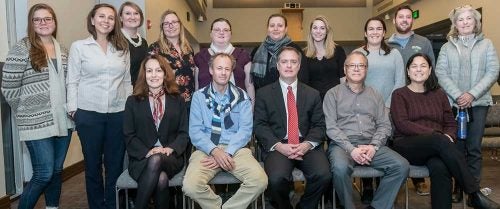
Every environmental crisis needs a hero. DDT had Rachel Carson, the author and scientist who exposed the perils of the pesticide DDT. Hexavelent chromium had Erin Brockovich, a law clerk who helped bring about the largest single-payer settlement to victims of groundwater pollution in Hinckley, CA. And PFAS, or poly- and perfluoroalkyl substances, have Robert Bilott, an attorney employing litigation to protect public health from PFAS threats.
Bilott’s story, and the story of PFAS in Parkersburg WV, plays out like a modern Hollywood portrayal of David and Goliath. After years of working with chemical corporations to facilitate compliance with environmental regulations, Bilott took on a somewhat more adversarial position by representing the people of Parkersburg, WV against DuPont. Through years of legal research, seven years of scientific investigation, and several courtroom battles, Bilott and his team exposed the grim scope of DuPont’s chemical misconduct.
Despite knowing about the human health risks of PFAS since the 1960s, DuPont had dumped waste containing the chemical PFOA—one type of PFAS—into landfills. The compound made its way into local waterways and downstream drinking water supplies, with subsequent health impacts in humans and livestock. DuPont was also aware of PFOA’s burgeoning environmental presence well before regulatory agencies or exposed individuals were made aware. By uncovering this trail of recklessness, Bilott’s investigation resulted in a settlement for the initial complainant and a follow-up class action lawsuit representing people from the wider Ohio River Valley who had or were drinking PFOA-laced water.
As part of the class action lawsuit, a seven-year comprehensive study of the health effects of PFOA found six problems linked to PFOA exposure: high cholesterol, ulcerative colitis, thyroid disease, testicular cancer, kidney cancer, and pregnancy-induced hypertension. As a result, DuPont paid almost $670 million dollars to PFOA-impacted people in six water districts across the Ohio River Valley.

Yet Bilott’s work is not finished. On October 4, 2018, he filed a class action lawsuit on behalf of all Americans with PFAS in their blood—or 98% of the American public—against eleven PFAS-producing companies.
His latest litigation tackles a larger swath of PFAS compounds, by compelling PFAS-polluting companies to fund studies examining health effects associated with more types of PFAS beyond just PFOA. Such data would greatly benefit exposed populations by providing evidence of harm related to PFAS exposure. Without such information, concerned citizens must take on the burden of proof that individual harm was caused by a specific PFAS compound—a vastly more onerous undertaking.
Providing such proof of harm is also an uphill battle for communities without the aid of a legal champion like Bilott, as polluters often possess significant financial means and a substantial legal team as a bulwark to potential lawsuits. Moreover, any in-house scientific studies proving harmful health impacts of PFAS are shielded by confidentiality. Polluters use these management strategies to protect themselves from legal consequences and allow continuation of their habitual polluting.
These are the stories that rarely reach the likes of the New York Times. Communities around the country are left to question if their water or air is making them sick and these aren’t idle questions. There are hundreds of PFAS-contaminated sites around the country with more coming to light almost daily.

“There is tremendous fear, anxiety, and uncertainty across the country as to the serious public health threat posed by PFAS contamination. This lawsuit could provide a mechanism for addressing and resolving those concerns through a truly comprehensive and independent, science-based process paid for by those that actually created the problem – and not by the American taxpayers,” says Bilott of his most recent litigation.
Moving forward as a modern-day David vs the Goliath of PFAS manufacturers, Bilott’s work promises continued relevance to communities and individuals around the globe, as we all stand to benefit from more prudent practices related to PFAS. With his great skill and a bit of luck, future generations will come closer to an environment devoid of the mindless chemical polluting that we are grappling with today, in large part due to Bilott’s diligence and unwavering commitment to environmental justice.
Featured at the November 15th STEEP Colloquium Speaker series, Bilott is a partner with Cincinnati-based corporate defense firm Taft Stettinius & Hollister LLP.
Anna Robuck is a STEEP trainee and a PhD candidate with STEEP Project 4 led by Dr. Rainer Lohmann. Robuck analyzes PFAS in seabird tissue and marine surface waters to determine PFAS bioaccumulation potential in estuarine and marine environments. In addition to being a STEEP trainee, Robuck is a NOAA Nancy Foster Scholar.

